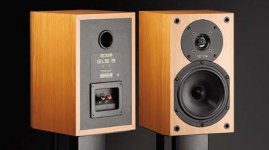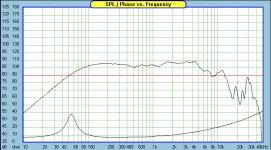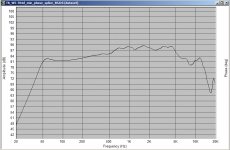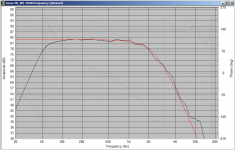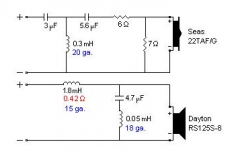3 ways aren't that hard with suitably chosen drivers. They all follow the Duelund target slopes.
Uh- what? Not all 3-ways follow Duelund targets. In fact, only certain drivers are capable of making the Duelund alignments work.
Later,
Wolf
Cool someone else has done a build with the D5G's. How did you like the sound Wolf?I have used the D5G, and in a 2-way. The tweeter I used is the Neo3PDR, currently not available, but the design was solid. I had to xover at 1.9k, and it did work rather well.
Photos:
Trichotomy by Wolf Teeth | Photobucket
Let me know if you have any questions,
Wolf
It seems like everyone has been leaning towards the tang band so it looks like i will be using that driver. All i have to do now is learn how to use boxsim...
I have been looking at other threads that have been discussing the tang band w5 704d and according to them, the specs on tang bands website are way off. Can i use the specs on zaphaudio or are the 704d and 704s too different?
Thanks, Jeremy
Thanks, Jeremy
I think that 8 ohm Tang Band W5 704D looks like a wicked little 5" polycone! Low inductance, flat response, underhung voicecoil and even a phase plug. 🙂
Tang Band W5-704D 5-1/4" Woofer
If it is me, I have to have an inspiration to build a speaker. A point of departure that interests me. Now these sort of speakers aren't "le dernier cri" in bass response. But if we reflexed a 5" bass in a decent sized 8-12L cabinet, it might surprise. 5" polycone and metal tweeter? Well there are some goodish anticedents. The Epos ELS-3 and the Harbeth P3ESR. Below.
Just for fun, read Lou Corragio's effort with a similar flat Tang Band 4 ohm 5" paper woofer and your EXACT tweeter. Doesn't look too hard, does it? I love reading that guy. A minor great in audio IMO.
TunDar Transmission Line Mini Tower Speaker
Tang Band W5-1685 5" Underhung Midbass Driver
Because you might use a 8 ohm bass, the bass filter will be bigger on inductance but smaller on shunt capacitance by about 1.5. But doable. I won't go into the whole thing, but you might end up close to this neat little design:
Peerless HDS PPB 830860
Tang Band W5-704D 5-1/4" Woofer
If it is me, I have to have an inspiration to build a speaker. A point of departure that interests me. Now these sort of speakers aren't "le dernier cri" in bass response. But if we reflexed a 5" bass in a decent sized 8-12L cabinet, it might surprise. 5" polycone and metal tweeter? Well there are some goodish anticedents. The Epos ELS-3 and the Harbeth P3ESR. Below.
Just for fun, read Lou Corragio's effort with a similar flat Tang Band 4 ohm 5" paper woofer and your EXACT tweeter. Doesn't look too hard, does it? I love reading that guy. A minor great in audio IMO.
TunDar Transmission Line Mini Tower Speaker
Tang Band W5-1685 5" Underhung Midbass Driver
Because you might use a 8 ohm bass, the bass filter will be bigger on inductance but smaller on shunt capacitance by about 1.5. But doable. I won't go into the whole thing, but you might end up close to this neat little design:
Peerless HDS PPB 830860
Attachments
I have been looking at other threads that have been discussing the tang band w5 704d and according to them, the specs on tang bands website are way off. Can i use the specs on zaphaudio or are the 704d and 704s too different?
Thanks, Jeremy
according to this post http://www.diyaudio.com/forums/mult...-1-4-woofer-has-anybody-used.html#post1547898 they should be interchangable 🙂 certainly looking at zaph's measurement it looks a little nicer than the tang band datasheet one, and it should be relatively easy to get it to play ball whilst dealing with baffle step as well.
Tony.
I think that 8 ohm Tang Band W5 704D looks like a wicked little 5" polycone!
Low inductance, flat response, underhung voicecoil and even a phase plug. 🙂
Hi,
Very highly rated by Zaph for value, but its not an underhung driver, and its not a phase plug.
rgds, sreten.
Last edited:
Hey Guys
Finally got around to designing the crossover. Didn't really know what I was doing but I eventually got a crossover design. Just wondering if it is any good and if there is anything I need to add to it. At first I was manually inputting data from an online crossover calculator and after I let boxsim optimize it . I also put a zobel circuit in it not even knowing what it does...
Anyway here are some pics:
Thanks for the help
Jeremy
Finally got around to designing the crossover. Didn't really know what I was doing but I eventually got a crossover design. Just wondering if it is any good and if there is anything I need to add to it. At first I was manually inputting data from an online crossover calculator and after I let boxsim optimize it . I also put a zobel circuit in it not even knowing what it does...
Anyway here are some pics:
An externally hosted image should be here but it was not working when we last tested it.
An externally hosted image should be here but it was not working when we last tested it.
Thanks for the help
Jeremy
Hi Jeremy, I think you are going to need a little bit of baffle step compensation there. You can probably do it by just upping the value of the first coil and padding down the tweeter a bit.
If you drop the tweeter maybe 3db and try a bigger initial coil to get a flatter (rather than rising from 100Hz) response on the woofer that would be a good starting point.
If you are going to put them hard up against the wall (or in the corners) it may not be such an issue.
Tony.
If you drop the tweeter maybe 3db and try a bigger initial coil to get a flatter (rather than rising from 100Hz) response on the woofer that would be a good starting point.
If you are going to put them hard up against the wall (or in the corners) it may not be such an issue.
Tony.
Hey Tony, I tried to flatten out the rise from 100 Hz by attenuating the tweeter a bit more and adding a larger inductor but I ended up with a hump from around 100 to 500 Hz that I couldn't seem to get rid of. I have done some research and have got a flatter response from 100 to 500 Hz by using a notch filter. How does the rest of the graph look now?
I am not too keen on using a notch filter as it adds a lot to the cost of the crossover (20 USD per 5mH inductor) so any other advice would be much appreciated.
Thanks, Jeremy
An externally hosted image should be here but it was not working when we last tested it.
An externally hosted image should be here but it was not working when we last tested it.
I am not too keen on using a notch filter as it adds a lot to the cost of the crossover (20 USD per 5mH inductor) so any other advice would be much appreciated.
Thanks, Jeremy
Hmmm that's a seriously big notch!! 😉 since a notch is a tuned circuit you should be able to use other value components to do the same job (though perhaps with higher Q) (hopefully I'm not talking out of my rear here 😉 )
Take a look at this post http://www.diyaudio.com/forums/multi-way/277192-hivi-morel-2-way-temporary-xo-help.html#post4394651 funnily enough another (different) HiVi driver. The notch I did for that looks to have been in the same range and is using much smaller values, although it is for two in parallel, so probably roughly half the impedance... Too late for me to try and think whether that should make the values smaller or larger! 😉
edit: the general FR is looking a lot better. You may not even need that much BSC (the tradeoff is lower efficiency). How big is the hump without the notch?
Tony.
Take a look at this post http://www.diyaudio.com/forums/multi-way/277192-hivi-morel-2-way-temporary-xo-help.html#post4394651 funnily enough another (different) HiVi driver. The notch I did for that looks to have been in the same range and is using much smaller values, although it is for two in parallel, so probably roughly half the impedance... Too late for me to try and think whether that should make the values smaller or larger! 😉
edit: the general FR is looking a lot better. You may not even need that much BSC (the tradeoff is lower efficiency). How big is the hump without the notch?
Tony.
Last edited:
I went back and checked that, and the notch was around 1.2Khz, have a try with 2mH 50uF and 6 ohms and see what that does. I think that for a series connected shunt notch the impedance of the load is not so important...
Tony.
Tony.
This is the response without the notch:
I tried with the 2mH 50uF and 6ohm as you recommended however i found that an increased size cap made the response much flatter. (600uF)
and the circuit:
I was mucking around for a bit trying to get the inductor size down and I ended up with this:
The software optimisation seems to have made some of the values for the tweeter a bit large.
Which of these two do you think is the best?
Jeremy
An externally hosted image should be here but it was not working when we last tested it.
I tried with the 2mH 50uF and 6ohm as you recommended however i found that an increased size cap made the response much flatter. (600uF)
An externally hosted image should be here but it was not working when we last tested it.
and the circuit:
An externally hosted image should be here but it was not working when we last tested it.
I was mucking around for a bit trying to get the inductor size down and I ended up with this:
An externally hosted image should be here but it was not working when we last tested it.
An externally hosted image should be here but it was not working when we last tested it.
The software optimisation seems to have made some of the values for the tweeter a bit large.
Which of these two do you think is the best?
Jeremy
Last edited:
I fixed some of the massive values caused by the optimisation.
An externally hosted image should be here but it was not working when we last tested it.
An externally hosted image should be here but it was not working when we last tested it.
It kind of doesn't matter how you get the response right, only that you do.I have done some research and have got a flatter response from 100 to 500 Hz by using a notch filter.
The sim is going to show you this mostly above a few hundred Hertz. For example..
This is where in room measurements become necessary. It's best to find the smoothest in room response through the baffle step before you decide how much compensation to apply.You may not even need that much BSC (the tradeoff is lower efficiency).
Eg, there is a speaker against the wall. Below the frequency where the path to the wall and back to the baffle is less then 1/4 wavelength there will be no more baffle step. However from there on up until the frequency where little sound diffracts around the baffle each frequency will eityher come back intact and almost at the right level, or could be cancelled. There are worse things, but dealing with sharp changes in the response can be enough to deal with.
Hmmm those caps are too big to be practical. The hump is very broad, I'd be inclined to play around with no notch, drop back to 2nd order electrical at first increase the size of the 1st inductor and see how that goes.
Another option would be to look at a dedicated BSC circuit, but often you can get away without it.
Also when you are running the optimizer are you running it on the whole circuit or just parts? also over the whole freq range or only the range of interest. I've not used boxsim (other than a quick look) so am not familiar with the optimizer, but I know that the one in speakerworkshop it is important to limit the frequency ranige to the area of interest when doing notches (as well as doing separate optimizations for the notch and the other components).
Tony.
Another option would be to look at a dedicated BSC circuit, but often you can get away without it.
Also when you are running the optimizer are you running it on the whole circuit or just parts? also over the whole freq range or only the range of interest. I've not used boxsim (other than a quick look) so am not familiar with the optimizer, but I know that the one in speakerworkshop it is important to limit the frequency ranige to the area of interest when doing notches (as well as doing separate optimizations for the notch and the other components).
Tony.
Jeremy, What are your baffle dimentions? Did you use Zaph's SPL measurement for your TB spl data? The TB actually has a dip in the 500Hz range so I'm a bit surprised you are getting a hump specifically in this range.
I'm suspicious that your spiced in low frequency data is being spliced at two low a level (I'm not sure how this works in boxsim) resulting in a step down. Something doesn't look quite right.
Below is Zaph's measured data, if you spiced in your low frequency sim at around 200Hz I don't think you should see the step down that you are (between 200 and 100 Hz). Zaph's measurement is not in an ideal box (in fact they are not in a box at all) and you probably should not use it below about 200Hz IMO.
Tony.
I'm suspicious that your spiced in low frequency data is being spliced at two low a level (I'm not sure how this works in boxsim) resulting in a step down. Something doesn't look quite right.
Below is Zaph's measured data, if you spiced in your low frequency sim at around 200Hz I don't think you should see the step down that you are (between 200 and 100 Hz). Zaph's measurement is not in an ideal box (in fact they are not in a box at all) and you probably should not use it below about 200Hz IMO.
Tony.
Attachments
Last edited:
I have used Zaphs measurements for the ZMA:

These are some rough drawings I've done. Should the baffle be bigger and is it good to have some chamfer? Depth of box is not set yet as I don't know how much room all the components and sound dampening will take up. The volume is going to be around 20 litres.

All these dimensions have been inputted into boxsim:

When I only hook the woofer to the amp in the sim this is what it looks like:

For the optimiser:
I usually only optimise one section at a time; notch, zobel etc
You can manually choose which components to optimise (They are the components coloured in red as seen on previous posts)
Thanks for all the help,
Jeremy.

These are some rough drawings I've done. Should the baffle be bigger and is it good to have some chamfer? Depth of box is not set yet as I don't know how much room all the components and sound dampening will take up. The volume is going to be around 20 litres.

All these dimensions have been inputted into boxsim:

When I only hook the woofer to the amp in the sim this is what it looks like:

For the optimiser:
I usually only optimise one section at a time; notch, zobel etc
You can manually choose which components to optimise (They are the components coloured in red as seen on previous posts)
Thanks for all the help,
Jeremy.
OK looks like what you are getting out of boxsim matches what I get when I use the tools I am used to. I suspect 20L is a bit big for this woofer and resulting in some droop in the response with a peak before it cuts off.
Chamfers are good, whether 18mm will have much effect or not is debatable (I think I went with 25mm chamfers, and even that is not making that much difference).
You can try varying the baffle dimensions and see what difference it makes to the response curve, also try changing the height of the speaker on the baffle. Best thing is to experiment 🙂
Tony.
Chamfers are good, whether 18mm will have much effect or not is debatable (I think I went with 25mm chamfers, and even that is not making that much difference).
You can try varying the baffle dimensions and see what difference it makes to the response curve, also try changing the height of the speaker on the baffle. Best thing is to experiment 🙂
Tony.
Attachments
Hi Jeremy, I did a little playing tonight with notch, but went back to basics. Something like this is simple and may work well. It does roughly 1/2 BSC rather than full which if you are not too far from the walls will probably be fine.
Something to think about anyway. It's 4th order bessel acoustic target (83db) at 2.4Khz.
Depends of course whether it will blend in with the tweeter of course (phase wise) but shows that the driver/box can be tamed without doing anything tricky 🙂 Note the low frequency was simmed in an 11L vented tuned to 54 (I think) Hz.
Tony.
Something to think about anyway. It's 4th order bessel acoustic target (83db) at 2.4Khz.
Depends of course whether it will blend in with the tweeter of course (phase wise) but shows that the driver/box can be tamed without doing anything tricky 🙂 Note the low frequency was simmed in an 11L vented tuned to 54 (I think) Hz.
Tony.
Attachments
We always have fun working together, don't we Tony! We get there. 😀
5" woofer and tweeter is one of the easier speakers to get working IMO. No reason to go particularly low on the crossover. 3.5kHz will keep everything in its comfort zone. If Boxsim optimiser starts throwing up extreme values on components, it usually means they are redundant. But you should still leave a few reasonable values fixed and let the optimiser work round them. Like the bass coil and the first tweeter capacitor.
Troels likes an LCR 700Hz notch on speakers to keep them from shouting whilst using smallish bafflestep coil which can sound livelier:
Peerless HDS PPB 830860
The cheap and cheerful alternative is about 2mH of coil and 6uF shunt on the bass and everything falls into place. You could even put a little 0.3mH coil in front of the bass after the cap for a sort of third order bass, but you may then need to add a 1-2R resistor to the shunt cap to keep things well behaved, especially on phase which you shouldn't overlook to align within 10-20 degrees.
The Microbe (an interesting design that keilau found whilst exploring SEAS tweeters) is using a metal bass, so it adds a 0.05mH coil for a notch of cone breakup. You won't need that with a polycone which has better rolloff.
5" woofer and tweeter is one of the easier speakers to get working IMO. No reason to go particularly low on the crossover. 3.5kHz will keep everything in its comfort zone. If Boxsim optimiser starts throwing up extreme values on components, it usually means they are redundant. But you should still leave a few reasonable values fixed and let the optimiser work round them. Like the bass coil and the first tweeter capacitor.
Troels likes an LCR 700Hz notch on speakers to keep them from shouting whilst using smallish bafflestep coil which can sound livelier:
Peerless HDS PPB 830860
The cheap and cheerful alternative is about 2mH of coil and 6uF shunt on the bass and everything falls into place. You could even put a little 0.3mH coil in front of the bass after the cap for a sort of third order bass, but you may then need to add a 1-2R resistor to the shunt cap to keep things well behaved, especially on phase which you shouldn't overlook to align within 10-20 degrees.
The Microbe (an interesting design that keilau found whilst exploring SEAS tweeters) is using a metal bass, so it adds a 0.05mH coil for a notch of cone breakup. You won't need that with a polycone which has better rolloff.
Attachments
Last edited:
- Status
- Not open for further replies.
- Home
- Loudspeakers
- Multi-Way
- Advice on bookshelf speaker build


